- Like
- Digg
- Del
- Tumblr
- VKontakte
- Buffer
- Love This
- Odnoklassniki
- Meneame
- Blogger
- Amazon
- Yahoo Mail
- Gmail
- AOL
- Newsvine
- HackerNews
- Evernote
- MySpace
- Mail.ru
- Viadeo
- Line
- Comments
- Yummly
- SMS
- Viber
- Telegram
- Subscribe
- Skype
- Facebook Messenger
- Kakao
- LiveJournal
- Yammer
- Edgar
- Fintel
- Mix
- Instapaper
- Copy Link
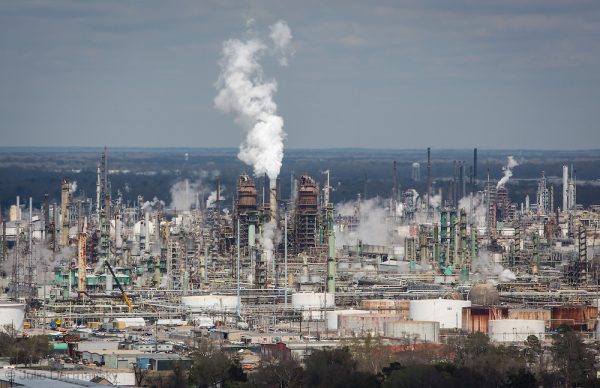
March 8, 2014, Baton Rouge, Exxon Mobile refinery as seen from the top of the Louisiana State Capitol Building. The area from Baton Rouge to New Orleans is know to many as ‘Cancer Alley’ due to the high number of oil and gas industry sites.
See our #NoASH #PetroFreeWV page here:
Appalachian Storage Hub/Petrochemical Complex
According to recent reports, the so-called “Appalachian Storage Hub” (ASH) has cleared its first hurdle. The U.S. Department of Energy has granted the first part of a two application loan of $1.9 billion for the Appalachia Storage & Trading Hub initiative. Heading this project is the Appalachian Development Group (ADG) owned by Mid-Atlantic Technology, Research and Innovation Center (MATRIC) and the WVU Innovation Corp.
This hub has already been called a number of different names ranging from the Appalachian Ethane Storage Hub to ADG’s Storage and Trading Hub; each sounding more benign than the other. What it really should be called is the Appalachian Petrochemical Hub. If it is developed, this hub would bring a massive build up of the petrochemical industry stretching down the Ohio River from Beaver, PA, to Huntington, WV. It would stretch into surrounding counties with a spur from down the Kanawha River from Point Pleasant, WV, to Charleston. It could potentially make the “Chemical Valley” in Kanawha County look like an afterthought. Champions of the proposed hub see this as a good thing.
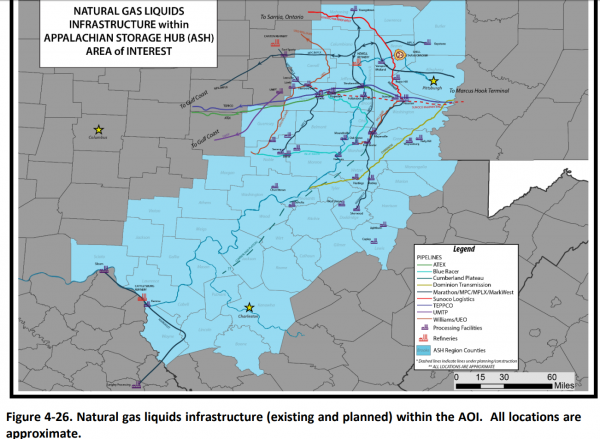
Map showing current (existing and planned) NGL Infrastructure in the area. This map does not show pipelines and other infrastructure for “dry gas” (methane) production. The infrastructure would increase if the Hub is developed. Click to enlarge.
The hub would mean the construction of a slew of petrochemical refineries, pipelines, and more. Hub-related facilities would use the leftover liquid by-products of methane production (called natural gas liquids or NGLs, though there is nothing “natural” about it), so that would mean an increase of fracking-related activity and infrastructure as well. The two would need to feed one another.
More fracking for methane leads to more gas liquids used by the petrochemical companies, the more gas liquids petrochemical companies use ,the more fracking will happen. What that means is our region would face the combined threats of more fracking and the petrochemical industries.
Of course, those with vested interests are touting this as the latest great news jobs-savior for our region. The American Chemistry Council is touting its own report that imagines the hub attracting up to $36 billion in new chemical and plastics industry investment, and 100,000 new area jobs. The accuracy of the report is yet to be determined. The long-term viability of those jobs is another question, too. One wonders what kind of other jobs prospects we’d have in the region if a massive petrochemical complex further destroys our air and water. Would most of the much-touted jobs go to locals, or will many of the potential jobs go to out-of-state workers, as we already see in the oil and gas industry here?
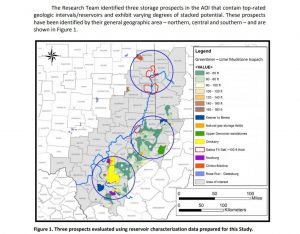
ASH maps in this blog are from a report prepared by the Appalachian Oil and Natural Gas Consortium at WVU. Click on this map to follow a link to the report.
Haven’t we learned any lesson from what the coal industry has done, where the majority of what is produced here is exported elsewhere, and the profits made by companies from outside the region? Not to mention it is all a boom and bust mono-economy.
When you peel back the “jobs” argument, what’s left are more hazards than benefits. This petrochemical hub would mirror the one already in existence in Louisiana, known as “Cancer Alley” (watch a short film here on Cancer Alley) along the Mississippi River. We have been talking with folks there and they have experienced troubles from higher cancer rates and illnesses to massive sinkholes. Do we really want all of that in our backyards too?
All one has to do is pick up a copy of the book Petrochemical America to see the impact this industry has really had on folks in Louisiana. These companies expect people to ignore the hazards as long as there are dollar signs involved.
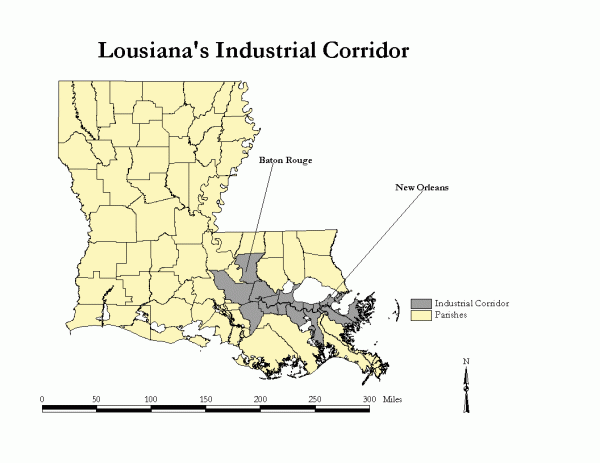
Map of Louisiana’s Industrial Corridor, aka “Cancer Alley.”
Once again the people of Appalachia are being told that we “need” to put health and safety on the line for industry profit. Who is going to protect us when something goes wrong? The current EPA is very pro-industry and our own WV Department of Environmental Protection has already proven time and time again it can’t protect the people of West Virginia. We have already had a long history of industry disasters here in the state. Its only a matter of time before something goes drastically wrong with this hub. Remember when methylcyclohexane methanol was difficult to say? Imagine what words come with the petrochemical industry. Understand that the products these facilities will be making are toxic to people. Keep in mind, too, this hub will not only impact people in West Virginia, but folks in Ohio, Pennsylvania, and part of Kentucky too. The Ohio River is the source of drinking water for more than three million people and almost 10% of the U.S. population (more than 25 million people) lives in the Ohio River Basin.
This hub of horrors is a nightmare waiting to happen. We Appalachians need to defend ourselves from this monstrosity and stand in support with folks in Louisiana already living the nightmare. The people deserve better than false economic hope and toxic neighbors.

Illustrated map of the area know as “Cancer Alley” in Louisiana and the types of chemicals being produced.
Here’s more from OVEC on the ASH petrochemical nightmare:
It’s Not a Done Deal: Say “No!” to Appalachian Storage Hub – Part 1
Robin Blakeman, Vivian Stockman: Gas storage hub a field of nightmares
And meanwhile, elsewhere…




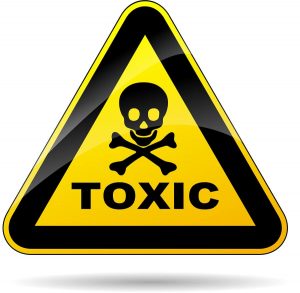






I was in Berkeley Springs last week for the hearing over the Mountaineer Gas Pipeline, Transcanada/Columbia pipeline, or the Potomac pipeline, depending on whom you talk to. NO ONE wanted it. EVERYONE spoke against it. 350 DC was there. They had gone to the DC City Council about this and the city council voted UNANIMOUSLY to stand against this pipeline because of the threats to the water there. 681,000 residents of Washington, DC and 17 million visitors per year get their water from the Potomac. It is their sole water source. They don’t even LIVE HERE and they had the sense to see this is a bad idea.
Relax. While I don’t share all of your concerns, rest assured that the leaders of the Appalachian Storage Hub (and other aliases) lack experience, common sense and above all, any knowledge whatsoever of the industry they are trying to create. The project will never get off the ground.
Will we never learn- and with this President He and our weak EPA will PUSH it
Through. WOW what a shame -We’ll let greed win out again.
I live in Mingo County. Fracking is a bad word to me and scares me to hear there’s going to be more. I have a fracked well behind my house. Everything about this project was a disaster. The gas company came through my property and cut trees w/o any permission, tore down my fence, damaged trees with large equipment, wrecked a truck in a ditch and spilled diesel fuel, tore up the dirt road so bad it will never be the same again. Shortly after the liquid nitrogen was put in the well there was a huge booming sound and then I guess they hit the gas line and the pressure of the fractured earth could be heard for miles. They left a hole in the ground filled with the horrors of whatever they chemicals they used and 8 years later NOTHING will grow in the ground where they spilled these chemicals. There’s a line of trees about 1/2 mile in a straight row that fell over. It’s a nightmare come true.
I live in Mingo County. Fracking is a dirty word to me. I have a “Fracked” well behind my home. When the gas company came through they destroyed the road, damaged my property, tore down my fences, cut trees w/o permission and left them to rot, damaged trees with the equipment that barely fit on the road leaving huge gaps and cracks in them, wrecked a chemical truck and spilled diesel and something else in the ditch, dumped chemicals on the ground from the drill site and nothing will grow on the land. They had plastic in a hole but it leaked out. When the liquid nitrogen was placed in the well and the pressure was released the ground shook and the noise could be heard for miles. There’s a 1/2 mile row of old growth trees down the mountain that just fell over in a straight row because of the subsidence that occurred. I can’t imagine what must have happened under the ground. It was a nightmare filled with horrors that lasted for months.